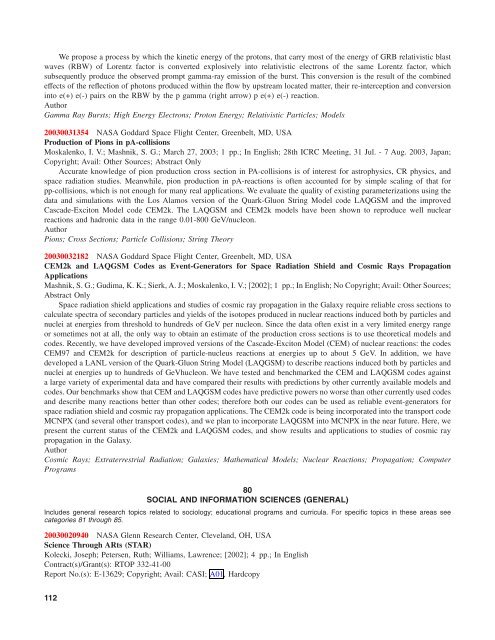You also want an ePaper? Increase the reach of your titles
YUMPU automatically turns print PDFs into web optimized ePapers that Google loves.
We propose a process by which the kinetic energy of the protons, that carry most of the energy of GRB relativistic blast<br />
waves (RBW) of Lorentz factor is converted explosively into relativistic electrons of the same Lorentz factor, which<br />
subsequently produce the observed prompt gamma-ray emission of the burst. This conversion is the result of the combined<br />
effects of the reflection of photons produced within the flow by upstream located matter, their re-interception and conversion<br />
into e(+) e(-) pairs on the RBW by the p gamma (right arrow) p e(+) e(-) reaction.<br />
Author<br />
Gamma Ray Bursts; High Energy Electrons; Proton Energy; Relativistic Particles; Models<br />
20030031354 NASA Goddard Space Flight Center, Greenbelt, MD, USA<br />
Production of Pions in pA-collisions<br />
Moskalenko, I. V.; Mashnik, S. G.; March 27, 2003; 1 pp.; In English; 28th ICRC Meeting, 31 Jul. - 7 Aug. 2003, Japan;<br />
Copyright; Avail: Other Sources; Abstract Only<br />
Accurate knowledge of pion production cross section in PA-collisions is of interest for astrophysics, CR physics, and<br />
space radiation studies. Meanwhile, pion production in pA-reactions is often accounted for by simple scaling of that for<br />
pp-collisions, which is not enough for many real applications. We evaluate the quality of existing parameterizations using the<br />
data and simulations with the Los Alamos version of the Quark-Gluon String Model code LAQGSM and the improved<br />
Cascade-Exciton Model code CEM2k. The LAQGSM and CEM2k models have been shown to reproduce well nuclear<br />
reactions and hadronic data in the range 0.01-800 GeV/nucleon.<br />
Author<br />
Pions; Cross Sections; Particle Collisions; String Theory<br />
20030032182 NASA Goddard Space Flight Center, Greenbelt, MD, USA<br />
CEM2k and LAQGSM Codes as Event-Generators for Space Radiation Shield and Cosmic Rays Propagation<br />
Applications<br />
Mashnik, S. G.; Gudima, K. K.; Sierk, A. J.; Moskalenko, I. V.; [2002]; 1 pp.; In English; No Copyright; Avail: Other Sources;<br />
Abstract Only<br />
Space radiation shield applications and studies of cosmic ray propagation in the Galaxy require reliable cross sections to<br />
calculate spectra of secondary particles and yields of the isotopes produced in nuclear reactions induced both by particles and<br />
nuclei at energies from threshold to hundreds of GeV per nucleon. Since the data often exist in a very limited energy range<br />
or sometimes not at all, the only way to obtain an estimate of the production cross sections is to use theoretical models and<br />
codes. Recently, we have developed improved versions of the Cascade-Exciton Model (CEM) of nuclear reactions: the codes<br />
CEM97 and CEM2k for description of particle-nucleus reactions at energies up to about 5 GeV. In addition, we have<br />
developed a LANL version of the Quark-Gluon String Model (LAQGSM) to describe reactions induced both by particles and<br />
nuclei at energies up to hundreds of GeVhucleon. We have tested and benchmarked the CEM and LAQGSM codes against<br />
a large variety of experimental data and have compared their results with predictions by other currently available models and<br />
codes. Our benchmarks show that CEM and LAQGSM codes have predictive powers no worse than other currently used codes<br />
and describe many reactions better than other codes; therefore both our codes can be used as reliable event-generators for<br />
space radiation shield and cosmic ray propagation applications. The CEM2k code is being incorporated into the transport code<br />
MCNPX (and several other transport codes), and we plan to incorporate LAQGSM into MCNPX in the near future. Here, we<br />
present the current status of the CEM2k and LAQGSM codes, and show results and applications to studies of cosmic ray<br />
propagation in the Galaxy.<br />
Author<br />
Cosmic Rays; Extraterrestrial Radiation; Galaxies; Mathematical Models; Nuclear Reactions; Propagation; Computer<br />
Programs<br />
80<br />
SOCIAL AND INFORMATION SCIENCES (GENERAL)<br />
Includes general research topics related to sociology; educational programs and curricula. For specific topics in these areas see<br />
categories 81 through 85.<br />
20030020940 NASA Glenn Research Center, Cleveland, OH, USA<br />
Science Through ARts (STAR)<br />
Kolecki, Joseph; Petersen, Ruth; Williams, Lawrence; [2002]; 4 pp.; In English<br />
Contract(s)/Grant(s): RTOP 332-41-00<br />
Report No.(s): E-13629; Copyright; Avail: CASI; A01, Hardcopy<br />
112
















